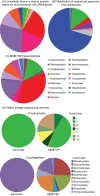The Marine Microbial Eukaryote Transcriptome Sequencing Project (MMETSP): illuminating the functional diversity of eukaryotic life in the oceans through transcriptome sequencing
- PMID: 24959919
- PMCID: PMC4068987
- DOI: 10.1371/journal.pbio.1001889
The Marine Microbial Eukaryote Transcriptome Sequencing Project (MMETSP): illuminating the functional diversity of eukaryotic life in the oceans through transcriptome sequencing
Abstract
Current sampling of genomic sequence data from eukaryotes is relatively poor, biased, and inadequate to address important questions about their biology, evolution, and ecology; this Community Page describes a resource of 700 transcriptomes from marine microbial eukaryotes to help understand their role in the world's oceans.
Conflict of interest statement
The authors have declared that no competing interests exist.
Figures


Similar articles
-
Decontamination, pooling and dereplication of the 678 samples of the Marine Microbial Eukaryote Transcriptome Sequencing Project.BMC Res Notes. 2021 Aug 9;14(1):306. doi: 10.1186/s13104-021-05717-2. BMC Res Notes. 2021. PMID: 34372933 Free PMC article.
-
Large-scale patterns in biodiversity of microbial eukaryotes from the abyssal sea floor.Proc Natl Acad Sci U S A. 2010 Jan 5;107(1):115-20. doi: 10.1073/pnas.0908816106. Epub 2009 Dec 10. Proc Natl Acad Sci U S A. 2010. PMID: 20007768 Free PMC article.
-
Ocean plankton. Eukaryotic plankton diversity in the sunlit ocean.Science. 2015 May 22;348(6237):1261605. doi: 10.1126/science.1261605. Science. 2015. PMID: 25999516
-
Censusing marine eukaryotic diversity in the twenty-first century.Philos Trans R Soc Lond B Biol Sci. 2016 Sep 5;371(1702):20150331. doi: 10.1098/rstb.2015.0331. Philos Trans R Soc Lond B Biol Sci. 2016. PMID: 27481783 Free PMC article. Review.
-
Marine Protists Are Not Just Big Bacteria.Curr Biol. 2017 Jun 5;27(11):R541-R549. doi: 10.1016/j.cub.2017.03.075. Curr Biol. 2017. PMID: 28586691 Review.
Cited by
-
Evidence-based green algal genomics reveals marine diversity and ancestral characteristics of land plants.BMC Genomics. 2016 Mar 31;17:267. doi: 10.1186/s12864-016-2585-6. BMC Genomics. 2016. PMID: 27029936 Free PMC article.
-
Gene expression during bacterivorous growth of a widespread marine heterotrophic flagellate.ISME J. 2021 Jan;15(1):154-167. doi: 10.1038/s41396-020-00770-4. Epub 2020 Sep 12. ISME J. 2021. PMID: 32920602 Free PMC article.
-
Phylogenetic proximity drives temporal succession of marine giant viruses in a five-year metagenomic time-series.bioRxiv [Preprint]. 2024 Aug 14:2024.08.12.607631. doi: 10.1101/2024.08.12.607631. bioRxiv. 2024. PMID: 39185240 Free PMC article. Preprint.
-
Toward Accurate and Quantitative Comparative Metagenomics.Cell. 2016 Aug 25;166(5):1103-1116. doi: 10.1016/j.cell.2016.08.007. Cell. 2016. PMID: 27565341 Free PMC article. Review.
-
Combined Genome and Transcriptome Analyses of the Ciliate Schmidingerella arcuata (Spirotrichea) Reveal Patterns of DNA Elimination, Scrambling, and Inversion.Genome Biol Evol. 2020 Sep 1;12(9):1616-1622. doi: 10.1093/gbe/evaa185. Genome Biol Evol. 2020. PMID: 32870974 Free PMC article.
References
-
- Worden AZ, Allen AE (2010) The voyage of the microbial eukaryote. Curr Opin Microbiol 13: 652–660. - PubMed
-
- Burki F, Keeling PJ (2014) Rhizaria. Curr Biol 24: R103–107. - PubMed
-
- Armbrust EV, Berges JA, Bowler C, Green BR, Martinez D, et al. (2004) The genome of the diatom Thalassiosira pseudonana: ecology, evolution, and metabolism. Science 306: 79–86. - PubMed
Publication types
MeSH terms
LinkOut - more resources
Full Text Sources
Other Literature Sources

